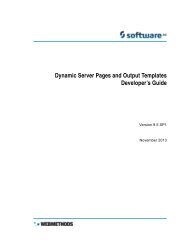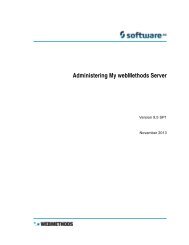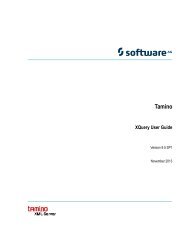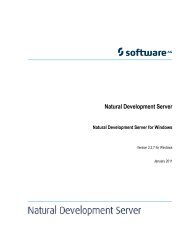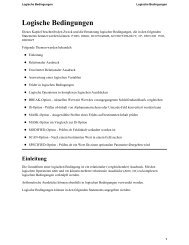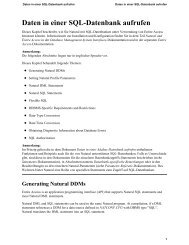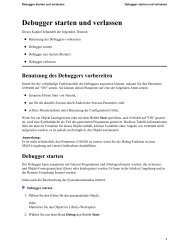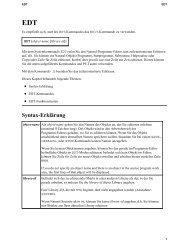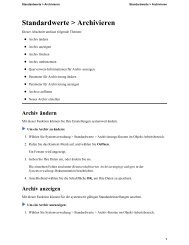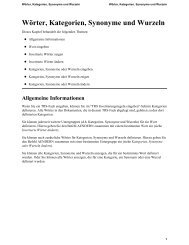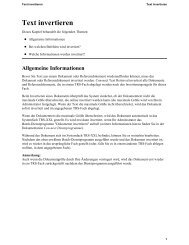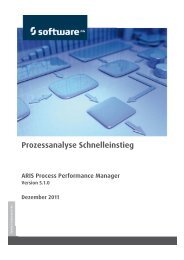Ending Entire System Server - Software AG Documentation
Ending Entire System Server - Software AG Documentation
Ending Entire System Server - Software AG Documentation
You also want an ePaper? Increase the reach of your titles
YUMPU automatically turns print PDFs into web optimized ePapers that Google loves.
The general recommendation for the operation of <strong>Entire</strong> <strong>System</strong> <strong>Server</strong> is to define the parameter<br />
TRACE=PREP to reserve a trace buffer (default 8 KB) and to set TRACE-SAV=YES. Then TRACE can be<br />
switched on or off at will by way of an operator command.<br />
For TRACE-SAV, definition of a disk file is required. Under z/OS, a TRACE DD statement is required.<br />
Under z/VSE, a TRACSAV DLBL (preferred) or TLBL is required, and it is assigned to SYS021. The<br />
data is fixed length, 288 bytes. Under BS2000/OSD, assignment is via the logical file name TRACE<br />
(for example., under BS2000/OSD: /SET-FILE-LINK LINK-NAME=TRACE,FILE-NAME=name); the data<br />
is written sequentially in variable record format with a length of 4K as a maximum.<br />
The following list supplies information about the file attributes:<br />
Option<br />
BS2000/OSD<br />
z/OS<br />
z/VSE<br />
Explanation<br />
Size: SPACE=(4,4)<br />
Features: BLKSIZE=(STD,2),FCBTYPE=SAM,RECFORM=V<br />
DCB attributes of RECFM=FB, LRECL=288<br />
SAM (may be VSAM-managed), fixed length 288 bytes<br />
During startup of <strong>Entire</strong> <strong>System</strong> <strong>Server</strong>, the file is opened and checked for validity. If errors occur<br />
during this check or during creation of the file buffer, tracing will be deactivated and a corresponding<br />
operator message will be issued on the console.<br />
Trace Activation/Deactivation during Operation<br />
If <strong>Entire</strong> <strong>System</strong> <strong>Server</strong> was started by means of TRACE=PREP or TRACE=YES and the initialization<br />
was successful, tracing may be switched on or off by operator command during operation. To do<br />
this, the commands TRACE=Y or TRACE=N are available. This enables the tracing to be limited to<br />
specific circumstances. A trace stopped with TRACE=N can be switched on again at any time by<br />
means of TRACE=Y.<br />
Trace Data Evaluation Using the Diagnosis Program ESYTRACE<br />
As mentioned above, trace data is stored unformatted. A separate program, ESYTRACE, is supplied<br />
which formats the raw data. It reads these data in the trace buffer during operation or reads the<br />
file created by TRACE-SAV=YES, which is written at termination or ABEND of the <strong>Entire</strong> <strong>System</strong><br />
<strong>Server</strong> and which represents a mirror image of the trace data available at the time of termination.<br />
The prepared result data can both be written to a file and/or to SYSPRINT (z/OS), SYSLST (z/VSE)<br />
or SYSOUT (BS2000/OSD). Output is written to an optional file - TRACEOUT DD (z/OS), TRACOUT<br />
(SYS002) DLBL or TLBL (z/VSE) or TROUT (BS2000/OSD).<br />
ESYTRACE is controlled by parmameters, which are passed to it via the PARM parameter of the<br />
JCL/JCS EXEC statement (z/OS, z/VSE) or RDATA (BS2000/OSD).<br />
The following parameters are supported:<br />
Administration<br />
Common <strong>Entire</strong> <strong>System</strong> <strong>Server</strong> Features<br />
83



